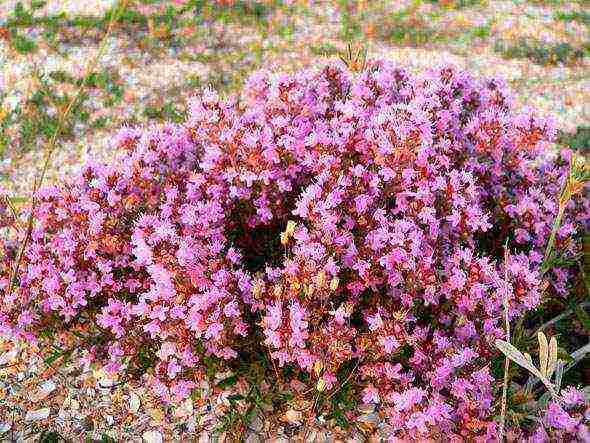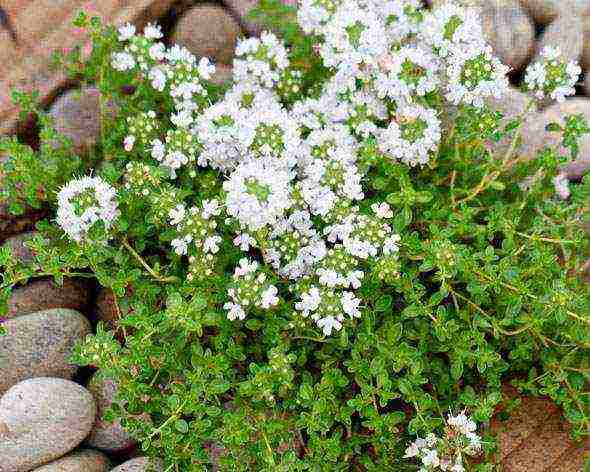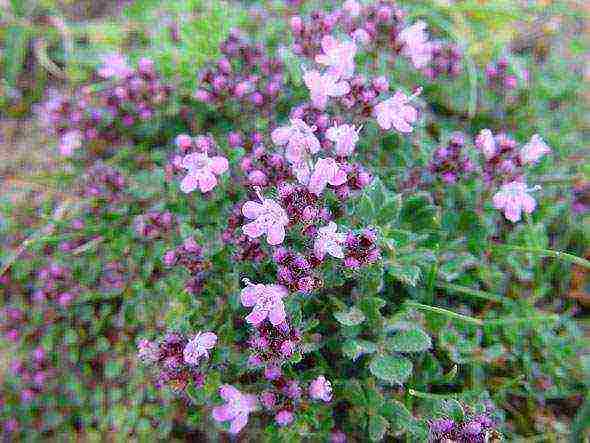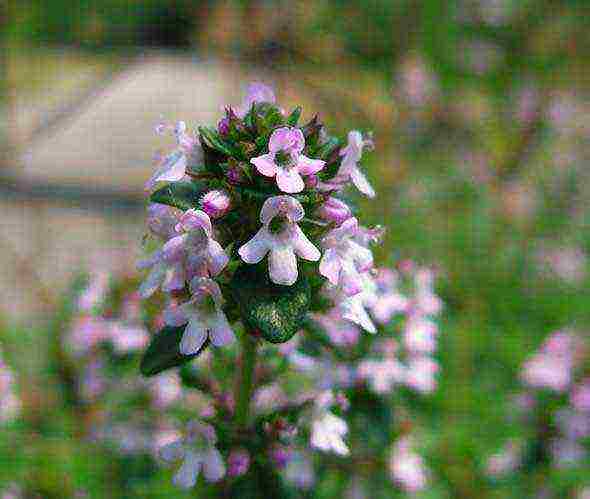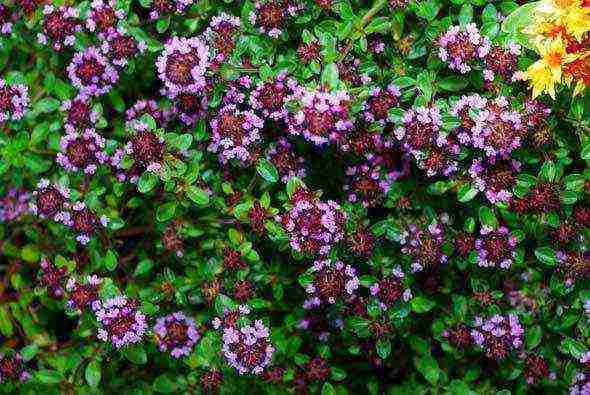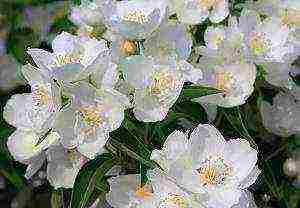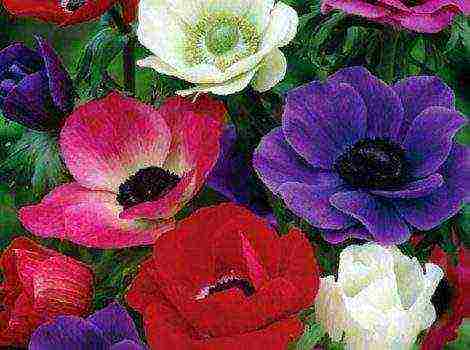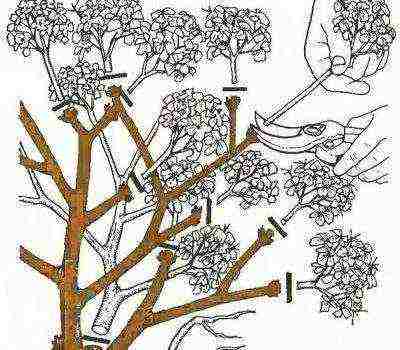Content
- 1 Thyme: types and varieties
- 2 Thyme: planting and caring for the site
- 3 Watering
- 4 Top dressing
- 5 Pruning
- 6 Reproduction
- 7 Diseases and pests
- 8 Thyme in landscape design
- 9 Thyme: planting and care at home
- 10 Thyme in the home medicine cabinet
- 11 Popular varieties
- 12 Sowing
- 13 Thyme care
- 14 Thyme: benefits and harms
- 15 Thyme: description
- 16 Types of thyme
- 17 Lemon-smelling thyme: description
- 18 Varieties
- 19 Lemon-smelling thyme: planting and care
- 20 Thyme propagation
- 21 Use in the garden
- 22 Cooking use
- 23 Medicinal properties of thyme
- 24 Contraindications for use
- 25 Preparation and storage of raw materials
This herb is known to many. It grows almost everywhere, in fields and meadows. The thyme plant is just one of more than 400 members of the thyme genus, a low-growing shrub with a branched woody stem.
Thyme: types and varieties
Due to its unpretentiousness and adaptability, thyme grows in Europe, America, Asia and North Africa. Most common only 3 types:
- creeping thyme (it is he who is usually called thyme) - a lodging perennial shrub. Stems - numerous, thin, creeping, easily rooted, lignify with age at the base, forming ascending or erect flowering shoots that can reach up to 20 cm in height. The leaves are small, oblong-oval, with a short petiole; in a magnifying glass, one can see protruding, well-developed essential oil glands. Flowering occurs in June, July, the flowers are small, but abundant, purple-red, mauve or pinkish-blue, at the ends of the branches are collected in inflorescences. This species is extremely unpretentious, drought and frost resistant;
Creeping thyme
Creeping thyme
- common thyme is a low shrub, the height of the shoots reaches 15 cm. The leaves are small, with pubescence on the inner side. The flowers can be light lilac, white (Alba cultivar), deep red (Slendens cultivar). It is less hardy than creeping thyme. In landscape design, dwarf varieties of common thyme are actively used, for example, Elfin - without rising above 5 cm, one seedling forms a neat dense green "pillow" up to 15 cm in diameter;
Thyme Alba
Thyme ordinary
- lemon thyme - a low appearance, young leaves are ovoid, almost yellow in color, eventually turn light green. Popular for its spicy aroma with a rich hint of lemon scent. Not frost-resistant, needs shelter for the winter. In order for the plant to be dense, with a mass of greenery, it must be periodically cut, removing old shoots.
Lemon thyme
Lemon thyme
Thyme: planting and caring for the site
For planting thyme, sunny or light penumbra areas are selected, in the shade the shoots stretch sharply, the bush loses its solidity. The plant prefers fertile, light, well-drained, non-acidic (or neutral) soils. When preparing the site for planting on heavy soils, it is recommended to add sand when digging to improve the permeability of the soil. In addition, the place where the thyme grows must be protected from drafts.
Watering
Thyme is drought-resistant, does not tolerate stagnant water - this leads to damage and decay of the root system. Watering is moderate, only in a very dry period, as well as in a dry spring during the active growing season and preparation for flowering. To avoid stagnation on rainy days, the soil around the plant is mulched with fine gravel.
Top dressing
Thyme does not need enhanced fertilization. Before planting, humus can be added to the soil, then during the next year the plant will not need feeding.In subsequent years, top dressing is carried out in late spring or early summer with any liquid mineral fertilizer.
Pruning
Pruning is carried out in the spring, shortening the developing shoots, and after flowering, removing drying inflorescences. The shoot is cut to the lignified part, this is 2/3 of the total length of the stem. Pruning keeps the plant in shape and makes it dense and solid.
Reproduction
Thyme is propagated by seeds, cuttings and dividing the bush. It should be noted that the plant can reproduce well and abundantly by self-sowing, so over time it will be necessary to limit the area of its growth.
Since thyme seeds are very small and take almost a month to germinate, the area should be thoroughly weed before sowing. After germination, young plants develop rather slowly, they will require protection from weeds. That is why, when seed propagation, it is better to grow seedlings in containers first. At the beginning of March, seeds are sown in the soil mixture (equal parts of peat and sand), and the box is covered with glass on top until shoots appear. The grown seedlings are planted in the ground.
In summer, thyme reproduces well with green cuttings. Shoots root perfectly, therefore, before flowering, the tops of the stems 8-10 cm long are cut off, planted in river sand, and covered with foil. During the day, cuttings must be sprayed several times with a spray bottle. The roots appear on the 15-20th day, and after a month, the finished seedlings can be planted on the site. Growing thyme in the first year consists of regularly weeding and loosening the soil (mulching) to prevent stagnant water.
Propagating by division, the bush is broken at the base, after which the small roots are carefully disassembled (untangled). Planted cuttings can be covered with a glass jar for a week for better rooting.
Diseases and pests
In the first year after planting, the thyme should be regularly weeded, loosened and mulched to prevent water stagnation - the young root is especially sensitive to soil moisture saturation.
In general, pests almost never appear on thyme - the reason for this is the aromatic substances that it releases in large quantities. But nevertheless, if the rules of care are violated, the following insects can infect the thyme:
- meadow moth - affects leaves and stems, butterflies of this pest are especially active on warm nights. When signs of damage appear, the plant must be treated with insecticides;
- sandy sludge is a black beetle 7-10 mm long, affecting the entire ground part of thyme. Poisoned baits are used to combat it;
- weevil is a small (2-3 mm) black beetle that feeds on young greenery and shoots, as well as flower buds. The method of control is similar to sandy lollipop, plus insecticide treatment;
- aphids are small (up to several millimeters) sedentary insects that affect stems and leaves. They die after treatment with insecticides.
Thyme in landscape design
Thyme is an excellent ground cover, its undersized hybrids are resistant to damage, easily tolerate trampling, so they can be a good alternative to a traditional grass lawn.
In order for the thyme to grow more juicy greens, it must be cut more often and not allowed to bloom.
Thyme is often planted on alpine slides, it looks good in mixboards or stone gardens, as well as green edging the borders of paths and flower beds.
Because of the fragrant aroma, thyme is good for planting near gazebos or garden benches.
Thyme: planting and care at home
Thyme tolerates cultivation at home quite well, so that in autumn and winter you can always have a sprig of fresh fragrant seasoning on hand. For planting, you can use the soil for cacti. Thyme seeds can be sown in the spring, but it is better to take a bush from the garden in the fall, divide it and plant it in a container.In this case, the pot is chosen a little wider than the roots of the plant. It is very important to provide the plant with good drainage, because the thyme does not tolerate waterlogging.
In order for the thyme to grow and develop normally, it needs to provide the maximum possible amount of light, so it is installed on the southern, lightest window. Otherwise, the thyme will stretch upward without forming a dense bush with juicy greens.
Thyme in the home medicine cabinet
Before the advent of antibiotics, thyme oil was a powerful antiviral, antifungal, and antibacterial agent. Thyme contains coffee, cinchona, oleic, chlorogenic, ursular and oleanolic acids, fats, gums, flavonoids, vitamin C and many mineral salts. Tea and various infusions of thyme help with various diseases (cough, bronchitis, whooping cough, high blood pressure, circulatory problems), and are used as an immunity stimulator and general tonic. In addition, thyme is classified as an aphrodisiac.
In cooking, thyme is used as a spice and seasoning, but more often it is included in various spice mixtures.
If dried thyme is sewn into a bag and placed in a closet, it will reliably protect things from moths.
Planting a perennial plant of thyme, or thyme in the country, is valued among gardeners for its beauty during flowering. You can use thyme to decorate a rock garden or alpine slide. Small lilac, yellow, pink flowers and emerald-colored foliage form a beautiful continuous carpet on the lawn.

Thyme is indispensable for many viral and microbial ailments, and also gives a fragrant and pleasant taste in tea. It is grown from seeds immediately in the open field, it needs minimal care. It is enough to know the main features of thyme in order to reap a good harvest or enjoy lush flowering all season.
Popular varieties
Thyme can be harvested on the slopes of ravines, it is unpretentious and grows in various regions of the country. For planting in the country or personal plots, breeders have bred several varieties.
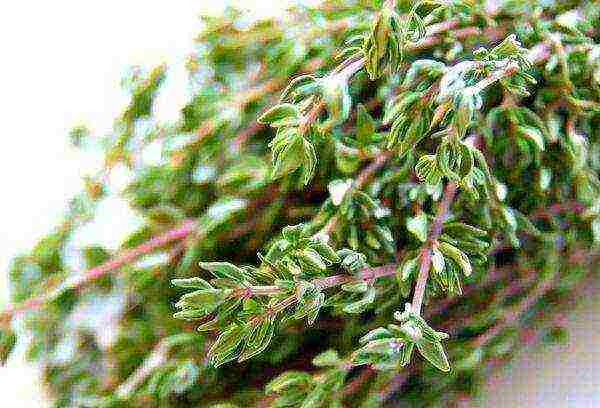
The species is ordinary thyme, or medicinal. The height of the bushes is 100-150 mm. Small flowers of lilac color, blurred almost to whiteness. Among this type, flower growers distinguish three varieties:
- Alba is a plant with white flowers;
- Splendens - the flowers of these bushes are colored red;
- Elfin is a 50 mm high bush that covers the ground with a circle of green foliage and flowers with a section of 150 mm.
The subspecies is creeping thyme. This is a perennial plant up to 150 mm high, it grows almost throughout the country. The length of the leaves is at least 10 mm. The foliage of the creeping thyme is green or variegated, and the flowers are red, whitish or pink.
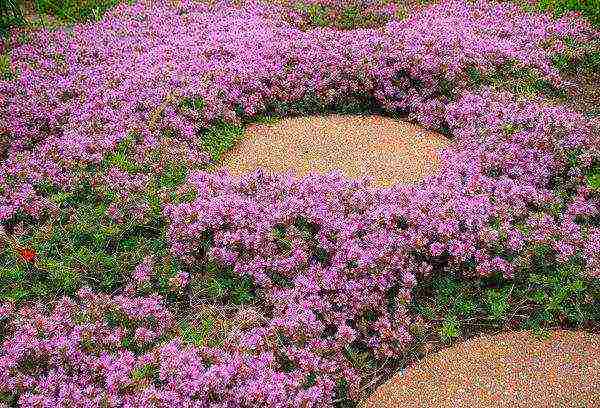
Lemon thyme. Among this species, varieties are popular:
- Silver Queen - its leaf plates have a pronounced white border along the edge;
- Duorf and Bertram Anderson are plants with bright yellow spots on the foliage;
- Golden King - the edging of the emerald foliage of these bushes is colored yellow.

Among the early varieties, Minor and Pseudolanuginosus are the most popular. On the bushes of the latter, so many small flowers bloom that foliage is not visible behind them. Minor is used for landing on an alpine hill. This slowly developing perennial completely covers the plot of land allotted for it with small inflorescences and leaves.
Important! Be careful when buying seed, otherwise thistle or stunted thyme bushes may grow on the flower garden.
Recommendations for the selection of seeds:
- do not take thyme of an unknown variety - if you plant thyme for the first time, be guided by the assortment that is given above;
- on the Internet or a reference book, study in detail the appearance of thyme seeds; if there is something different from the sample in the package, return the goods to the store;
- be sure to check the expiration date indicated on the package;
- do not try to save money on your purchase, buy only high-quality material from trusted manufacturers;
- by all means before planting, look at the dates of planting in open ground and harvesting. Planting seeds late will prevent plants from developing and producing fragrant flowers in the first year of growth;
- read the planting instructions, it is especially important to know the seeding depth and the distance between plants and rows.
Sowing
Thyme is easy to take and has good germination, so its seeds are planted immediately in the garden. To make the flower bed look neat, as well as to protect young shoots, you need to follow just a few rules for preparation and planting.
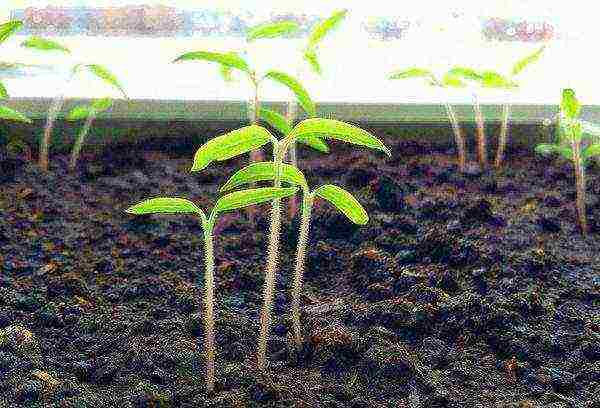
Seat selection
For planting, it is better to use the southern side of the site: thyme loves the sun. In the worst case, it is allowed to plant seeds in partial shade. When planting on clayey soils, it will be necessary to drain the beds, ensuring free passage of water and air to the roots, and preventing moisture stagnation. The best soil option for thyme is neutral or even with an increased level of alkali, light soil with a large layer of fertile soil.
They begin to prepare the site for planting in the fall. At this time, all the weeds are harvested until they have produced seeds. Then, for each square. meter beds are poured over a bucket of manure mixed with wood ash. Only after that, the bed is dug up and the roots of the weed are removed, while fertilizing the soil.
In the spring, a second preparatory stage is needed. As soon as the landing site is clear of snow, the ground is leveled and loosened with a rake. Then fertilize with a solution of urea (20 g of urea are stirred in 10 liters of water), well shedding the soil with it. The soil will be saturated with a nutrient solution within 24 hours, and after that you can start the main work.
Sowing
It is not necessary to pre-soak in water, especially in a growth stimulator, the seed material of thyme is not necessary. Harvesting seedlings also makes no sense. As soon as the soil in the garden warms up, i.e. in early May, the seeds are planted in the garden.
The work is carried out in several stages:
- Shallow grooves are drawn with a chopper. The distance between the rows is 300–500 mm, the depth is 15–20 mm.
- The rows are flooded with water, which will avoid a crust through which it will be more difficult for the sprouts to go up and get air and moisture.
- Thyme seeds are very small, so we advise you to mix them with dry river sand and fill the prepared rows. But if the seeds are collected independently or you were presented with them in large quantities, you can sow the rows, evenly, in a thin layer, pouring the material into them.
- Now you need to cover the seeds with a layer of soil. To do this, use sand, peat or plain earth. The main thing is that the soil is light and without lumps.
- Now, to create a constant humid and warm microclimate on the garden bed, it is covered with a film or black covering material.
After 14-18 days, the first sprouts of thyme will appear. It is necessary to remove the covering material and maintain moist, loose soil in the rows. In the aisles, the soil is loosened with a small hoe and young weeds are removed. It is impossible to water with a stream of water - it is better to use a sprinkler with a fine spray and fill the aisles. The soil, being soaked, will provide nourishment to the roots of the thyme.
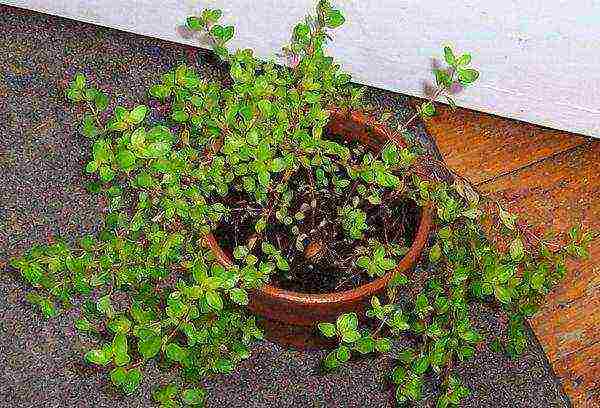
When several real leaves grow on the stalks, the planting is thinned out in the evening or on a cloudy day. Weak shoots are removed, leaving a gap of 90-100 mm between the plants. If you have to remove a strong seedling, they try to dive it to another place in the garden or plot, sometimes they give it to friends or acquaintances. Therefore, you should not pull out the sprouts - you need to carefully dig them up and take them out carefully, with a lump of earth. After thinning, the plants need to be watered by dissolving 20 g of urea in a bucket of water. This way, damaged sprouts will hurt less.
Plants will develop and become cramped again.Therefore, when the neighboring bushes begin to touch the crowns, it will be necessary to thin out the plantings again, leaving at least 200 mm between the shoots. After that, you should re-feed the thyme using any liquid complex fertilizer.
Growing thyme does not require a lot of time and effort. In the first year, the plant does not bloom, but with proper care, already in the next season, before the holiday of Trinity, you will harvest fragrant flowers.
Thyme care
Leaving, like disembarking, is simple. To maintain good conditions, a number of works will be required:
- weed control is a top priority, especially in the first year of thyme life. Bushes grow and cover the ground, so it will be difficult to deal with weeds in the future;
- moisture control: it is impossible to water the bushes abundantly, it is better to loosen the soil once again, allowing moisture to evaporate faster than to get a diseased plant due to stagnant liquid; thyme is not picky about watering and will calmly endure its absence for 10-14 days, even at high temperatures; it will be necessary to increase the number of watering in small portions only during the budding period;
- pruning: if you see that the bushes have grown a lot, it is recommended to prune long branches by adding a fragrant component to the tea;
- disease prevention: for this purpose, the aisles are usually covered with a thin layer of lime and ash; such treatment allows you to get rid of fungal diseases and pests;
- the right choice of tool: when harvesting, cutting off sprouts with flowers, be sure to use a knife or scissors; tearing off the stems will disrupt the root system;
- top dressing: after harvesting, the bushes must be fed with any complex fertilizer;
- preparation for winter: before frost, this heat-loving plant should be covered with straw or foliage;
- observance of crop rotation: after growing thyme in one bed for 4 years, it is better to transplant the bushes to another place.
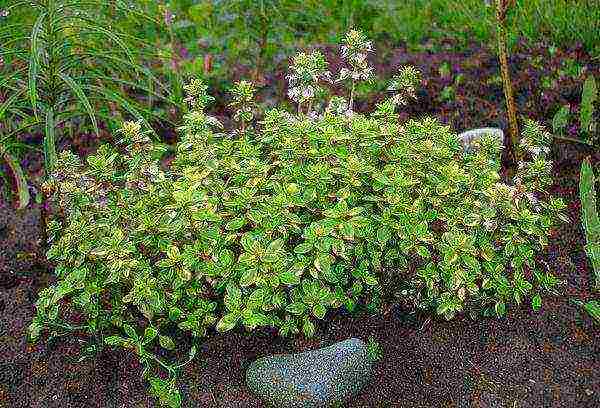
Thyme: benefits and harms
Thyme broths help with sore throat, gargling with it makes it easier to fight whooping cough and bronchitis. Thyme is a good antiseptic. Essential oils help relieve fatigue, stress and feelings of depression. In addition to the healing properties, the taste qualities of dried thyme flowers are used - they are used for preparing meat dishes and for brewing aromatic flower tea.
It is not recommended to drink tea and use thyme-based dosage forms:
- pregnant women at a later date;
- people with diseases of the vascular system;
- patients with kidney and liver pathologies;
- persons suffering from gastritis with high acidity.
By following simple rules and providing the thyme bushes with decent care, the next year you will receive an even carpet of beautiful bushes with carved leaves and fragrant flowers. The main thing is to love your work and be a little attentive, and a fragrant tonic drink in winter will be your reward for your work.
Thyme belongs to the family of the lamellar (labiate). It is a spicy-flavored perennial plant with a wide range of uses. Many varieties of it are planted in flower beds, the leaves harvested in summer are eaten all year round. In addition, it has medicinal properties.
Thyme: description
Thyme and its healing properties have been known since ancient times. Roman and Greek soldiers took baths with thyme infusion. They believed that it would give them strength and energy. At the same time, thyme began to be used in cooking as an aromatic plant. He came to Europe in the XI century.
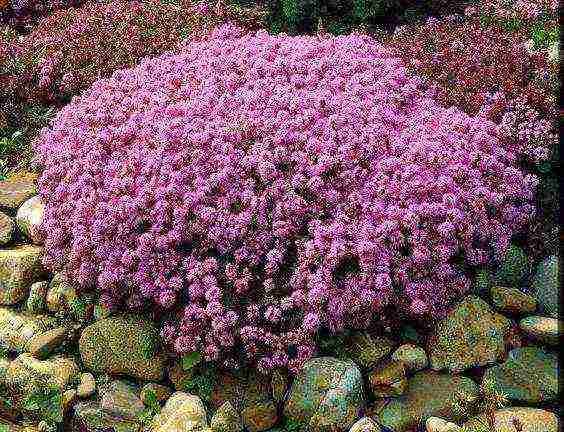
The height of the thyme bush usually does not exceed 40 cm. It is a perennial herb. Its stem is most often located on the ground, and the leaves rise upward. They are small, depending on the variety - monochromatic or variegated, often with a light border around the edge. The shape of the leaves is round, pointed. The flowers are light pink, small, but very fragrant. They are collected in inflorescences.
Not only flowers, but also thyme leaves have a pleasant aroma. For him, the plant received many popular names, each of which is common in a certain region of growth. These are thyme, lemon scent, hog pepper, flyfal.
Thyme in nature is a plant that can grow in almost any region of the world, where the length of the period with a positive temperature allows the seeds to ripen. It does not require any special care. In the southern regions it grows in the form of a shrub, in the northern regions it grows as a herbaceous perennial.
Types of thyme
Thymes have more than 3 hundred species. Basic:
- Creeping (Colchis, thyme) is an unpretentious shrub no more than 15 cm high. It grows, forming a fragrant carpet on glades and slopes. Has a "warm" aroma. Undemanding to soil, lighting, watering. Most often it grows on sandy soils, clearings of coniferous forests. Frost resistant. There are many decorative varieties of creeping thyme that bloom from mid-June to late summer with lilac or purple flowers. The entire ground part of the plant is harvested. You can pluck the leaves all summer. They are used to make a soothing tea, to treat colds.
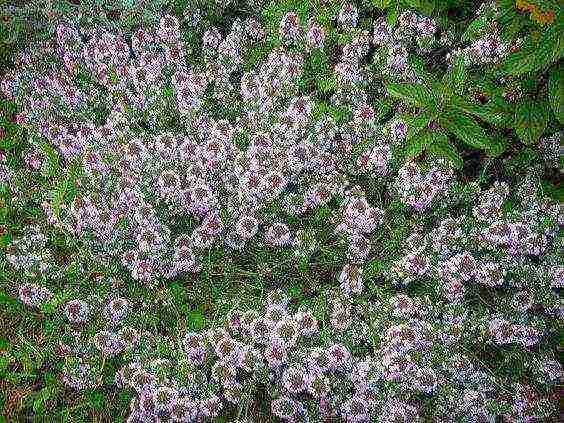
- Common, with bright green small leaves and light lilac flowers, collected in fragrant inflorescences. Herbaceous plant no more than 20 cm high. Grows in meadows and glades from early summer to August. It is not very frost-resistant, therefore, in a snowless winter, it can freeze with a sharp drop in temperature. The new plants will emerge from seeds that spilled onto the ground last summer. It also propagates by dividing the bush. In the composition of about 30% of the aromatic substance of thymol.
- Lemon-Smelling (Lemon) - A small plant that is prized for the lemon scent of its leaves. Created by natural crossing of common thyme with flea.
- Mossy with stems 1 cm high, densely intertwined, creates a fluffy carpet on the site.
Lemon-smelling thyme: description
It was discovered and described at the end of the 16th century. The scent of lemon is possessed not only by the leaves and flowers, but also by the stem. Lemongrass thyme (Thymus x citriodorus (Pers.) Schreb) has a low, slightly woody near the ground, slightly pubescent stem by autumn. It can be spread out or grow straight up. The stem is covered with small, up to 1 cm long and 3 mm wide, leaves on short, strong cuttings. The edges of the leaves are curved, smooth. Flowers are located on the stem, forming an inflorescence of spikes. The flower is bell-shaped, the calyx is two-lipped. The flower size is 4 mm.
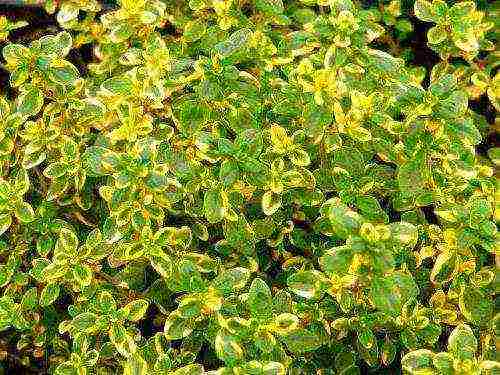
Lemongrass thyme stems tolerate frosts down to -18 ° C. Therefore, in most regions, it needs to be sheltered. If this is not done, the thyme will develop as an annual plant. New stems will form every year.
Varieties
Many varieties of lemon-scented thyme have been created. Most Popular:
- Donna Valley is a popular variety with bright green leaves covered with yellow spots. Doone Valley lemon-scented thyme is a short plant, less than 10 cm in height.
- Silver Queen is a popular perennial plant, reaching a height of 20 cm. The leaves are dark green with a white border on the side. Silver Queen lemon-scented thyme grows slowly. In winter, it needs to be protected from frost. In the summer they trim the bush so that it is more luxuriant.
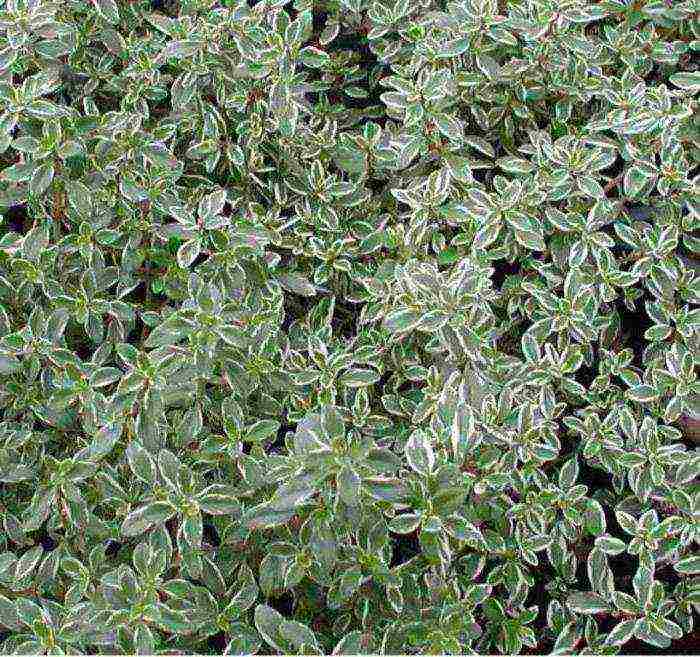
- Golden Duarf with light green leaves with yellow spots.
- Bertram Anderson lemon-scented thyme with light green leaves with a yellow border. Unpretentious frost-resistant variety. Grows well in the sun, but can tolerate light shade. Stretches out in the shadows. It is not affected by pests and diseases.
Lemon-smelling thyme: planting and care
Thyme is a light-loving plant that tolerates drought well. Therefore, it is planted in open areas and slopes. The soil should be light, with an admixture of sand. It will allow moisture to pass through well without causing water stagnation.If the land is fertile, it grows quickly. The height of the plants will be greater, and the lemon-smelling thyme will bloom more luxuriantly.
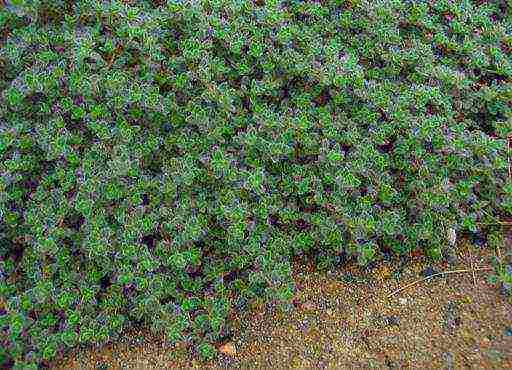
Care consists in removing weeds that can break through near the young plant. It is not affected by pests, therefore, chemical treatment is not carried out. Mature plants need to be trimmed every year to give them a neat look. This procedure will make the bush thick and beautiful.
You can transplant lemon-smelling thyme throughout the growing season: in spring, autumn and even summer. Watering is necessary in the first year after transplanting.
Thyme propagation
Thymes are propagated by dividing the bush. Thus, you can quickly get a beautiful clearing of fragrant plants. Lignified cuttings of lemon-scented thyme can be used. Planting can be done in autumn or spring.
Propagated by lemon-smelling thyme and seeds. They can be sown on the site after ripening without loosening the soil. They will rise next year.
Use in the garden
The use of lemon-scented thyme is due to its ability to quickly form fluffy colorful carpets on the site. It is grown on separate free lawns, on alpine hills.
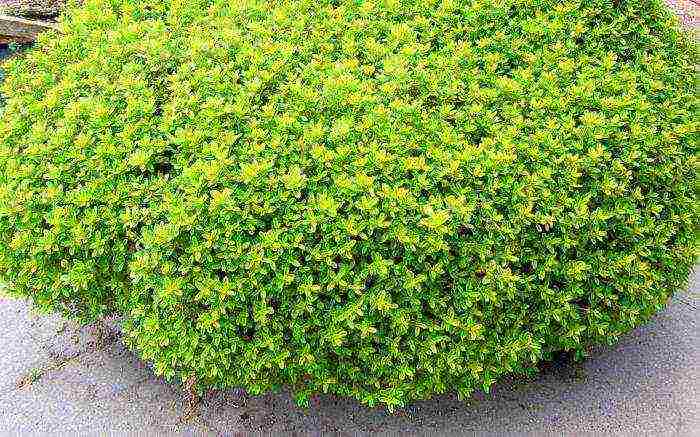
It can be planted alongside most bulbous plants, from ephemeral to lilies.
Cooking use
Lemongrass and common thyme are most often used in cooking.
Lemon-smelling thyme is widely used in cooking. It is consumed fresh in summer, and dried in winter. You can freeze the leaves for the winter. This allows you to experience the taste of summer at any time of the year. Add to the first (broths, soups) dishes, meat and fish, pates. A few thyme leaves will make a salad made from familiar vegetables much tastier and healthier. Add thyme leaves to the cheese. They also improve the taste of mushroom dishes.
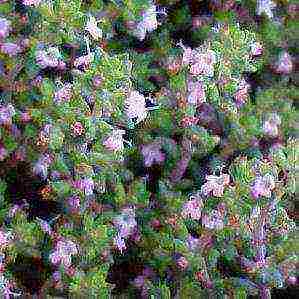
The advantage of lemon-scented thyme is that it does not lose its taste during cooking. Therefore, it can be thrown into the dish even at the start of cooking. This is how it differs from other types of seasonings.
By adding thyme leaves to fatty meals, it improves digestion and speeds up the digestion of such foods. Lemon thyme goes well with dishes from potatoes and various types of cabbage.
Thyme is indispensable when preserving tomatoes, zucchini and cucumbers. Together with dill and other herbs, a sprig of thyme is placed in a jar of pickles. Dried thyme gives the dishes a special aroma, adds a slight bitterness.
Thyme leaves added to compote allow you to get an original and healthy drink. Thyme sprigs are thrown into the jam when making it.
Original spirits are obtained by adding thyme shoots and leaves. They make them aromatic by imparting a lemon flavor and aroma.
Thyme is found in spices made for use with a variety of dishes.
Medicinal properties of thyme
From the harvested raw materials in folk medicine, infusions, lotions, compresses, decoctions are prepared.
The use of lemon-smelling thyme in official and folk medicine is associated with the presence in its composition of a very strong antibiotic carvacrol, which can fight Staphylococcus aureus. Thyme raw materials contain up to 2 percent of essential oils, thymol, linalol. They are used to fight germs, fungi, bacteria.
For the treatment of bronchitis and diseases of the upper respiratory tract, an extract of lemon-scented thyme is used. Its beneficial properties are well known. User reviews indicate a noticeable improvement in the condition of patients with bronchitis after using the drug. It has an expectorant effect, liquefies phlegm and promotes its excretion. Essential oils help soothe sore throat and throat areas.
Thyme infusions help in the treatment of inflammatory processes in the throat and oral cavity, if they are caused by purulent bacteria.
It contains a large amount of vitamins, acids, calcium, iron, magnesium, potassium, selenium and other elements. Therefore, the use of thyme leaves in food improves the general condition of the body. They contribute to the active secretion of gastric juice.
Tinctures of raw thyme help the intestines to process fatty foods, help to remove gases from the body.
Infusions of lemon-scented thyme leaves help relieve joint pain. They improve the condition of the musculoskeletal system, alleviate the condition with radiculitis and other neuralgic diseases. Gruel compresses made from fresh leaves are used. Mixing it with warm water, apply to the sore spot.
Neuroses are treated by adding one drop of essential oil to a teaspoon of honey and taken 3 times a day.
Use inhalations with essential oils and ethyl alcohol. They help get rid of coughs and colds.
Use decoctions of thyme leaves for skin diseases. Mix it with olive oil.
They increase blood pressure, improve appetite, sleep. For this, you can use aromatic baths. 0.5 kg of raw materials is steamed in several liters of water, boiled for a couple of minutes, insisted and added to the bath.
Contraindications for use
Thyme also has contraindications. Preparations with it should not be taken by pregnant women, people with liver and kidney disease, insufficient thyroid function. Thyme is contraindicated in cardiovascular diseases: atrial fibrillation, pre-infarction, elevated temperature. You can not use these funds for peptic ulcer disease.
If an overdose has occurred, nausea may be felt.
Preparation and storage of raw materials
The stems and leaves of plants of the first year of life are not harvested. Collect raw materials from the bushes of the second year. The leaves, flowers and stems of thyme are dried in the open air, protected from the sun's rays. You can do this in a room with good ventilation. Then they put it in storage. To prevent essential oils from evaporating, raw materials are stored in sealed glass jars, foil packages.
When preparing raw materials, thyme leaves are not crushed, otherwise the amount of essential oils will significantly decrease. This will manifest itself in the absence of odor.
When the thyme raw material dries up, its weight decreases, while the amount of essential oils remains approximately the same. Therefore, there are three times more of them in dry raw materials than in fresh ones. When adding it to various dishes, take this into account. Dried and crushed leaves need to be taken three times more than fresh ones.
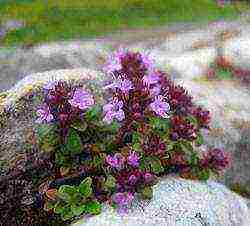 Thyme, or it is also called Bogorodskaya grass, is popularly called thyme. Its varieties are found not only in Europe, but also in Southeast Asia, as well as in northern Africa. Today we will introduce you to the most common varieties of thyme, describe in detail the process of growing, planting, care in the open field, and also pay attention to how to propagate a plant.
Thyme, or it is also called Bogorodskaya grass, is popularly called thyme. Its varieties are found not only in Europe, but also in Southeast Asia, as well as in northern Africa. Today we will introduce you to the most common varieties of thyme, describe in detail the process of growing, planting, care in the open field, and also pay attention to how to propagate a plant.
Creeping thyme: varieties and varieties
Creeping thyme belongs to the species of low-growing dwarf shrubs. The height of the plant rarely reaches over 15 cm. It is called so because of its peculiarity to creep along the soil, forming a soft fragrant carpet. The flowers have a bright purple hue and are collected in capitate inflorescences. This type is most often used by gardeners. It is used in landscape design because it blooms continuously all summer. The most common varieties of thyme are:
- "Colchis" - has light lilac flowers and spreads low (10 cm) on the ground;
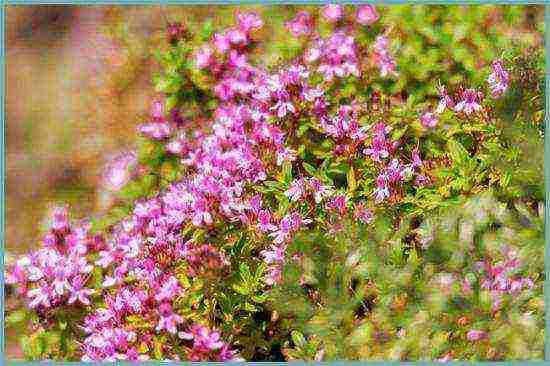
Variety "Kolkhida"
- "Donna Valley" - grows with a dense carpet, the leaves are bordered by a yellow stripe, the flowering is constant pink;
- "Silver Queen" - forms a rather high (20 cm) loose carpet, gray leaves with white edging, densely arranged inflorescences have a lavender hue.
Creeping thyme belongs to the type of thyme, among which you can also find:
- Common thyme.A plant with a small growth of 5-10 cm. The leaves have a light down at the bottom. Flowering - white and pale lilac shade.
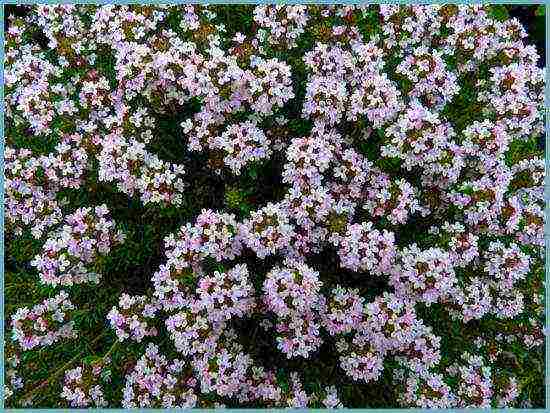
Thyme ordinary
- Lemon-scented thyme. It got its name due to its spicy aroma with subtle lemon notes, as well as the yellowish color of young leaves. The most popular varieties:
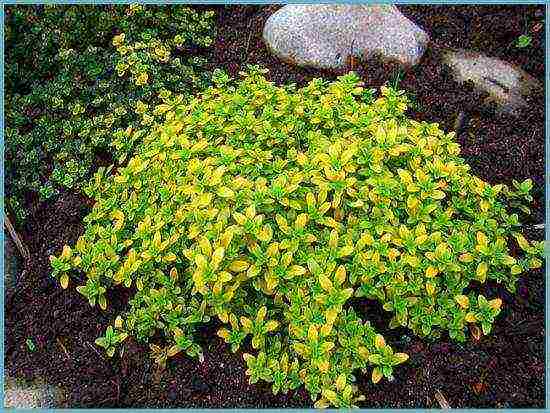
Lemon-scented thyme
- "Aurea" - has a bright yellow color;
- "Bertram Anderson" - has green leaves covered with yellow spots.
- Early thyme. It blooms earlier than others, but also fades a little faster. In our country, there are such varieties:

Early thyme
- "Minor" - has the slowest growth and small fluffy leaves;
- "Pseudolanuginosus" - has sharp green leaves with excessive pubescence, blooms very profusely.
Planting a plant
Thyme is grown on light, loose soil. Sunlight has a beneficial effect on its development, therefore, planting in open ground is carried out in a well-lit place.
In order for perennial plants to take root well, the site must be carefully dug up in the fall. And add organic fertilizer (compost or manure). In the spring, when the weather is warm outside with a temperature of at least 13 ° C, the soil is dug up again and seeds are sown.
Advice! After the thyme has been sown, you can sprinkle the seeds with river sand. It will provide young shoots with additional nutrients and prevent water from stagnating on the surface.
After the seedlings sprout and grow a little, it is necessary to thin out the planting. The ideal distance between plants is 30-35 cm.
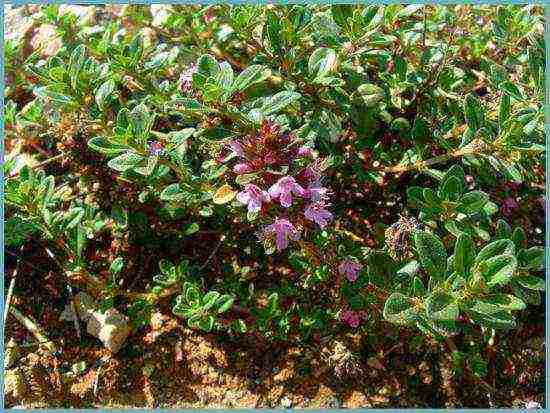
Fertilize and dig up the soil before planting thyme
In the open field, planting can also be carried out using seedlings. To do this, at the end of winter, thyme is sown in prepared trays. Watering the seedlings is carried out regularly, but not abundantly. Thyme rises under glass, which creates the effect of a greenhouse. After 3-4 weeks, the seedlings are taken out into the open air for hardening, and after another 2 weeks they are planted in a permanent place.
Thyme care
The first thing to do for the thyme after planting is to pin the tip of the stem, so the plant will form into a beautiful lush bush. Perennial crops need seasonal pruning. In autumn, when the flowering of thyme has stopped, it is necessary to shorten the bushes. In the new season, you will see how this procedure helped the plant to thicken and acquire a decorative shape.
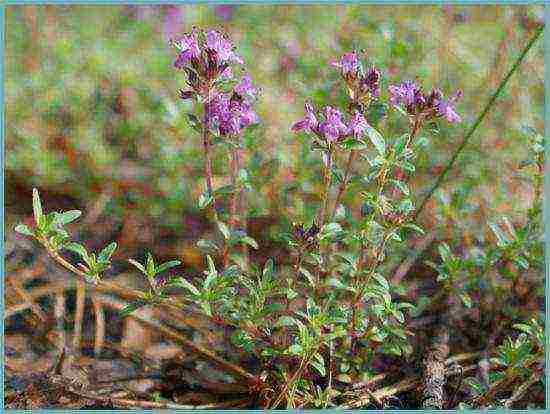
Shape the plant as it grows to create a beautiful bush.
It is very important for thyme to regularly weed and remove weeds, which draw out most of the nutrients from the soil. Since thyme is already growing rather slowly, "unwanted neighbors" will further inhibit its growth.
Caring for the plant also means watering it, which should be done no more than twice a week in dry weather and even less often if the summer is not very hot.
Important! Cover perennials with peat or fallen leaves for the winter.
Fertilization and feeding
It is undesirable for thyme to add fresh manure to the soil. Growing thyme outdoors allows the use of wood ash. It will not only add nutrients to the soil, but also reduce acidity.
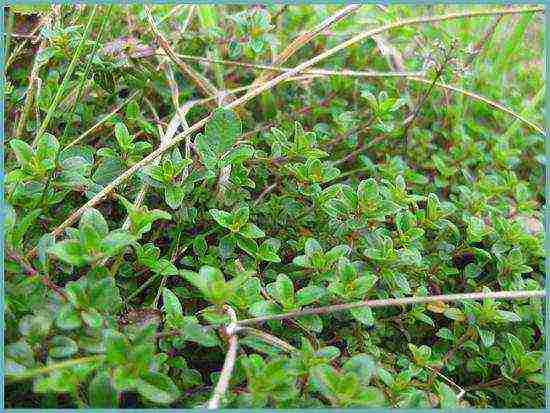
Feed perennials with mineral fertilizers
The first fertilization of thyme is carried out with urea in early spring. If this is the first year, then even before germination, and in the second and subsequent years with spring pruning.
Advice! Mineral fertilizers can be applied from the second year of life of creeping thyme.
Propagation of thyme
The propagation of varieties of creeping thyme in the open field is carried out in three ways:
- Seeds. The planting material is harvested in the fall and dried until spring. Then sow and cover with foil. Planting seeds in the fall is also allowed.
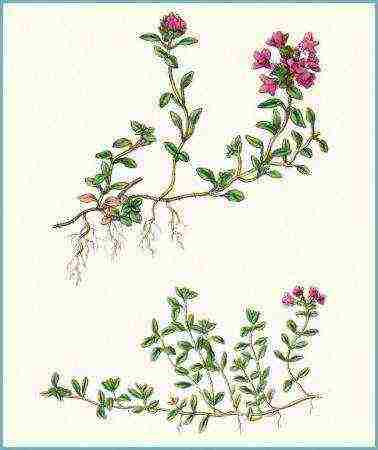
Pattern: thyme bush
- Cuttings. This method is convenient because the seedlings are already strong.Cuttings are selected for spring or autumn pruning. For planting, take the strongest of all. It is they who will subsequently form a new bush.
- By dividing the bush. A very painful method for the plant. When carrying out such a reproduction of thyme, the entire bush is dug up and divided in half. Special care is required. It is very important not to damage the root system, otherwise, the plant may get sick or even die.
Diseases and pests
Creeping thyme is very resistant to attacks of pathogenic bacteria and pests. Planting and caring for him is not difficult. It is unpretentious, but its only drawback is its slow growth.
The main pests of the Bogorodskaya grass are:
- weevil;
- meadow moth;
- aphid;
- sandy sludge.
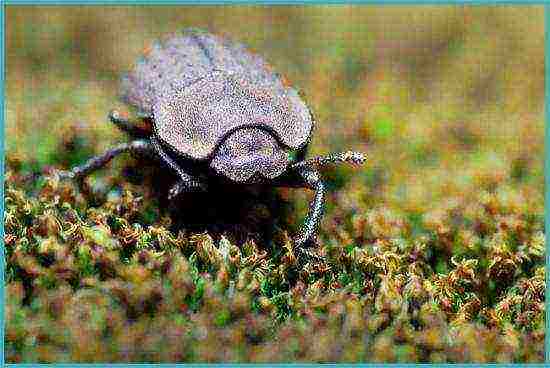
Sandy beetle
Thyme can also be affected by some fungal diseases. This is due to a violation of the cultivation technique. Excessive watering, rare weeding, shading of the plant lead to the spread of fungi on it.
Deep plowing, regular loosening of the root section of the soil, and timely weeding will save you from insect pests. Also, pests can be removed by applying fertilizer containing lime or other alkaline fertilizers.
Creeping thyme: combination with other plants
Thyme looks great in group or joint plantings. It can be used as a background for plants with large textured leaves. They often play on the contrast of colors in combination with geycher.
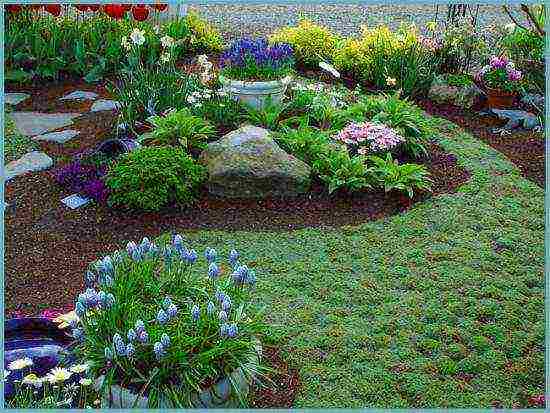
Thyme in landscape design
Thyme creeping with its powerful aroma attracts a large number of butterflies, bees and other pollinating insects. Therefore, it can be planted next to cucumber beds. Flying to the smell of thyme, the bees will help pollinate the rest of the vegetable crops.
Thyme or Bogorodskaya herb is the main component in the composition of bouquets made for the feast of the Holy Trinity. Such bundles also include wormwood, mint and lovage. Since ancient times, it was believed that the combination of their aromas will drive away all evil spirits from the dwelling.
Creeping thyme in landscape design
Being a low semi-shrub spreading along the ground, in landscape design, thyme is used as a background for alpine slides and mixboards. But he can act there and in the main role. Looks very good on scree.
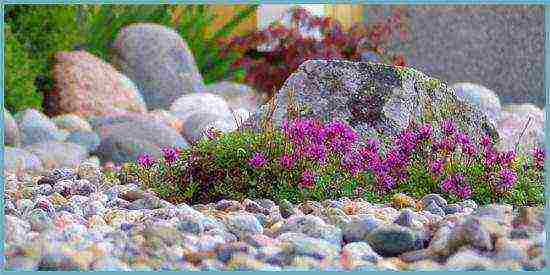
Rockery decoration with thyme
Growing creeping thyme will be a lot of fun for you. You can enjoy not only the beautiful appearance of the fluffy pillow bushes, but also its wonderful spicy scent. And what bright and rich photos are obtained against the background of thyme - just a feast for the eyes.
Growing thyme: video
Varieties of thyme: photo
